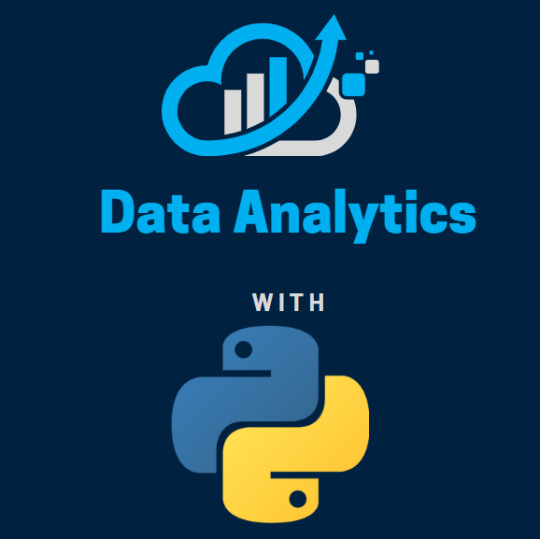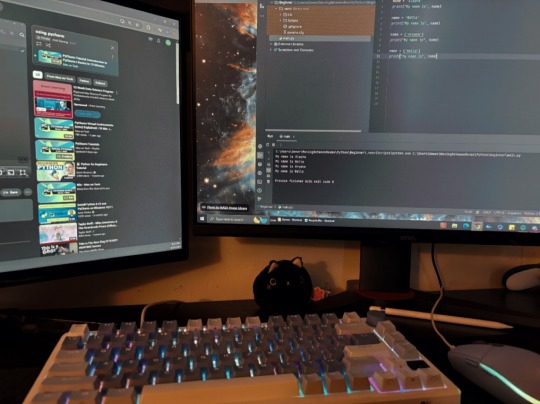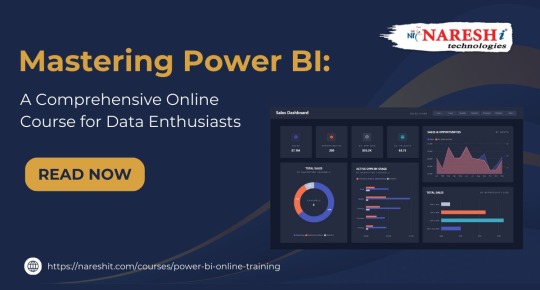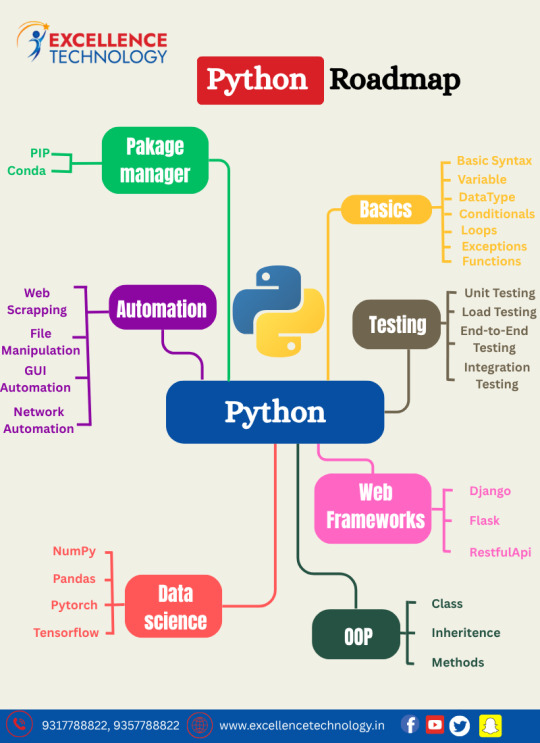#Data Analytics with Python
Explore tagged Tumblr posts
Text

In today's data-driven world, Python stands out as a versatile and powerful tool for extracting valuable insights from complex datasets. Whether you're a seasoned data professional or just starting in the field of analytics, Python offers a robust ecosystem of libraries and tools that empower you to manipulate, visualize, and analyze data efficiently.
0 notes
Text

Hey everyone! enjoying my (two) week break of uni, so I've been lazy and playing games. Today, working on Python, I'm just doing repetition of learning the basics; Variables, Data types, Logic statements, etc. Hope everyone has a good week!
#codeblr#coding#python#university#uni life#studying#datascience#data analytics#data analysis#studyblr#student life#study motivation#study blog#student
78 notes
·
View notes
Text
you say the only thing tethering me to this sport is a ship and i vehemently agree with you while trying to shove the python pipeline i built for fun to compare past race telemetry under the table
#i’m just a girl! why should i know anything beyond hehe man hot and be anything beyond little delusions with my friends#f1 is sadly not my only personality trait I’m also a fully paid researcher with intimate knowledge of data pipelines#you should’ve heard my rant about f1 using matlab to do analytics vs. a custom built python pipeline that I sent to the gc weeks ago#and don’t get it messed up I love lestappen too a woman can and will contain multitudes#hm. anyways
37 notes
·
View notes
Text
Understanding Outliers in Machine Learning and Data Science

In machine learning and data science, an outlier is like a misfit in a dataset. It's a data point that stands out significantly from the rest of the data. Sometimes, these outliers are errors, while other times, they reveal something truly interesting about the data. Either way, handling outliers is a crucial step in the data preprocessing stage. If left unchecked, they can skew your analysis and even mess up your machine learning models.
In this article, we will dive into:
1. What outliers are and why they matter.
2. How to detect and remove outliers using the Interquartile Range (IQR) method.
3. Using the Z-score method for outlier detection and removal.
4. How the Percentile Method and Winsorization techniques can help handle outliers.
This guide will explain each method in simple terms with Python code examples so that even beginners can follow along.
1. What Are Outliers?
An outlier is a data point that lies far outside the range of most other values in your dataset. For example, in a list of incomes, most people might earn between $30,000 and $70,000, but someone earning $5,000,000 would be an outlier.
Why Are Outliers Important?
Outliers can be problematic or insightful:
Problematic Outliers: Errors in data entry, sensor faults, or sampling issues.
Insightful Outliers: They might indicate fraud, unusual trends, or new patterns.
Types of Outliers
1. Univariate Outliers: These are extreme values in a single variable.
Example: A temperature of 300°F in a dataset about room temperatures.
2. Multivariate Outliers: These involve unusual combinations of values in multiple variables.
Example: A person with an unusually high income but a very low age.
3. Contextual Outliers: These depend on the context.
Example: A high temperature in winter might be an outlier, but not in summer.
2. Outlier Detection and Removal Using the IQR Method
The Interquartile Range (IQR) method is one of the simplest ways to detect outliers. It works by identifying the middle 50% of your data and marking anything that falls far outside this range as an outlier.
Steps:
1. Calculate the 25th percentile (Q1) and 75th percentile (Q3) of your data.
2. Compute the IQR:
{IQR} = Q3 - Q1
Q1 - 1.5 \times \text{IQR}
Q3 + 1.5 \times \text{IQR} ] 4. Anything below the lower bound or above the upper bound is an outlier.
Python Example:
import pandas as pd
# Sample dataset
data = {'Values': [12, 14, 18, 22, 25, 28, 32, 95, 100]}
df = pd.DataFrame(data)
# Calculate Q1, Q3, and IQR
Q1 = df['Values'].quantile(0.25)
Q3 = df['Values'].quantile(0.75)
IQR = Q3 - Q1
# Define the bounds
lower_bound = Q1 - 1.5 * IQR
upper_bound = Q3 + 1.5 * IQR
# Identify and remove outliers
outliers = df[(df['Values'] < lower_bound) | (df['Values'] > upper_bound)]
print("Outliers:\n", outliers)
filtered_data = df[(df['Values'] >= lower_bound) & (df['Values'] <= upper_bound)]
print("Filtered Data:\n", filtered_data)
Key Points:
The IQR method is great for univariate datasets.
It works well when the data isn’t skewed or heavily distributed.
3. Outlier Detection and Removal Using the Z-Score Method
The Z-score method measures how far a data point is from the mean, in terms of standard deviations. If a Z-score is greater than a certain threshold (commonly 3 or -3), it is considered an outlier.
Formula:
Z = \frac{(X - \mu)}{\sigma}
is the data point,
is the mean of the dataset,
is the standard deviation.
Python Example:
import numpy as np
# Sample dataset
data = {'Values': [12, 14, 18, 22, 25, 28, 32, 95, 100]}
df = pd.DataFrame(data)
# Calculate mean and standard deviation
mean = df['Values'].mean()
std_dev = df['Values'].std()
# Compute Z-scores
df['Z-Score'] = (df['Values'] - mean) / std_dev
# Identify and remove outliers
threshold = 3
outliers = df[(df['Z-Score'] > threshold) | (df['Z-Score'] < -threshold)]
print("Outliers:\n", outliers)
filtered_data = df[(df['Z-Score'] <= threshold) & (df['Z-Score'] >= -threshold)]
print("Filtered Data:\n", filtered_data)
Key Points:
The Z-score method assumes the data follows a normal distribution.
It may not work well with skewed datasets.
4. Outlier Detection Using the Percentile Method and Winsorization
Percentile Method:
In the percentile method, we define a lower percentile (e.g., 1st percentile) and an upper percentile (e.g., 99th percentile). Any value outside this range is treated as an outlier.
Winsorization:
Winsorization is a technique where outliers are not removed but replaced with the nearest acceptable value.
Python Example:
from scipy.stats.mstats import winsorize
import numpy as np
Sample data
data = [12, 14, 18, 22, 25, 28, 32, 95, 100]
Calculate percentiles
lower_percentile = np.percentile(data, 1)
upper_percentile = np.percentile(data, 99)
Identify outliers
outliers = [x for x in data if x < lower_percentile or x > upper_percentile]
print("Outliers:", outliers)
# Apply Winsorization
winsorized_data = winsorize(data, limits=[0.01, 0.01])
print("Winsorized Data:", list(winsorized_data))
Key Points:
Percentile and Winsorization methods are useful for skewed data.
Winsorization is preferred when data integrity must be preserved.
Final Thoughts
Outliers can be tricky, but understanding how to detect and handle them is a key skill in machine learning and data science. Whether you use the IQR method, Z-score, or Wins
orization, always tailor your approach to the specific dataset you’re working with.
By mastering these techniques, you’ll be able to clean your data effectively and improve the accuracy of your models.
#science#skills#programming#bigdata#books#machinelearning#artificial intelligence#python#machine learning#data centers#outliers#big data#data analysis#data analytics#data scientist#database#datascience#data
4 notes
·
View notes
Text
https://www.excellencetechnology.in/chandigarh-center/
#animation#programming#web development#web design#artificial intelligence#machinelearning#data analytics#datascience#python#javaprogramming#java course#digital marketing#seo
2 notes
·
View notes
Text

Hi, I’m Emie!
I’m learning Python, building a digital garden, and doing my best to grow gently through it all. My ultimate goal is to start a career in data analytics.
I love cozy aesthetics, soft creativity, and turning quiet moments into meaningful ones. This is my little corner of the internet where I can be myself—bear ears, tea, coding, and all.
I love AI and use it regularly. The image above is AI-generated.
I’m hoping to meet others who are also on their coding journey and maybe join—or build—a little community where we can support each other and grow together toward our goals. 🌿
4 notes
·
View notes
Text

2 notes
·
View notes
Text
What's the difference between Machine Learning and AI?
Machine Learning and Artificial Intelligence (AI) are often used interchangeably, but they represent distinct concepts within the broader field of data science. Machine Learning refers to algorithms that enable systems to learn from data and make predictions or decisions based on that learning. It's a subset of AI, focusing on statistical techniques and models that allow computers to perform specific tasks without explicit programming.

On the other hand, AI encompasses a broader scope, aiming to simulate human intelligence in machines. It includes Machine Learning as well as other disciplines like natural language processing, computer vision, and robotics, all working towards creating intelligent systems capable of reasoning, problem-solving, and understanding context.
Understanding this distinction is crucial for anyone interested in leveraging data-driven technologies effectively. Whether you're exploring career opportunities, enhancing business strategies, or simply curious about the future of technology, diving deeper into these concepts can provide invaluable insights.
In conclusion, while Machine Learning focuses on algorithms that learn from data to make decisions, Artificial Intelligence encompasses a broader range of technologies aiming to replicate human intelligence. Understanding these distinctions is key to navigating the evolving landscape of data science and technology. For those eager to deepen their knowledge and stay ahead in this dynamic field, exploring further resources and insights on can provide valuable perspectives and opportunities for growth
5 notes
·
View notes
Text
instagram
ou can become a data analyst ⤵️📈📊💯 Here’s what you need to do: - believe in yourself - learn Excel -learn SQL - learn Tableau - build Portfolio - update Linkedin - optimize Resume - Use Network -apply for jobs That’s the way. . . .
#data#dataanalyst#dataanalytics#analyst#analytics#workfromhome#codinglife#tech#teknoloji#programming#datascience#programmer#python#machinelearning#artificialintelligence#deeplearning#code#ai#Instagram
5 notes
·
View notes
Text
#data analytics#data analytics courses in delhi#best analytics courses in delhi#python for data analytics#best institute for data analytics#SoundCloud
2 notes
·
View notes
Text
Welcome to Data Analytics with Python
In today's data-driven world, the ability to harness the power of data for insights and decision-making has become essential across industries. Among the various tools and languages available for data analytics, Python stands out as a versatile and powerful option. Whether you're a newcomer to the field or an experienced professional looking to expand your skill set, mastering Data Analytics with Python can significantly enhance your capabilities and career prospects.
Why Python for Data Analytics?
Python has gained immense popularity in the realm of data analytics for several compelling reasons. First and foremost is its simplicity and readability, which makes it accessible even to those with minimal programming experience. The language's syntax is straightforward and easy to understand, allowing analysts to focus more on solving problems and less on deciphering complex code.
Furthermore, Python boasts a rich ecosystem of libraries specifically designed for data manipulation, analysis, and visualization. Libraries like Pandas provide powerful tools for handling structured data, allowing analysts to clean, transform, and merge datasets effortlessly. NumPy, another essential library, enables efficient numerical computing with support for multi-dimensional arrays and mathematical functions.
For visualizing data, Matplotlib and Seaborn offer robust capabilities to create a wide range of plots and charts, from simple histograms to complex heatmaps and interactive visualizations. These libraries not only facilitate clearer communication of insights but also enhance the overall understanding of data patterns and trends.
What You Will Learn
In a comprehensive Data Analytics with Python course, you can expect to cover a broad spectrum of topics designed to equip you with practical skills:
Python Fundamentals: Begin with the basics of Python programming, including variables, data types, control structures, and functions. This foundation is crucial for understanding how to manipulate and analyze data effectively.
Data Manipulation with Pandas: Dive deep into Pandas, the go-to library for data manipulation in Python. Learn how to load data from various sources, clean and preprocess datasets, perform aggregations, and handle missing data seamlessly.
Data Visualization with Matplotlib and Seaborn: Explore different plotting techniques using Matplotlib and Seaborn to create insightful visual representations of data. From simple line plots to complex scatter plots and heatmaps, you'll learn how to choose the right visualization for different types of data.
Statistical Analysis and Hypothesis Testing: Understand essential statistical concepts and techniques for analyzing data distributions, correlations, and conducting hypothesis tests. This knowledge is critical for making data-driven decisions and drawing reliable conclusions from data.
Machine Learning Basics: Gain an introduction to machine learning concepts and algorithms using Python libraries such as Scikit-learn. Explore how to build and evaluate predictive models based on data.
Real-World Applications and Projects: Apply your newfound skills to real-world datasets and projects. This hands-on experience not only reinforces theoretical concepts but also prepares you for practical challenges in data analytics roles.
Who Should Take This Course?
The Data Analytics with Python course is suitable for a wide range of professionals and enthusiasts:
Aspiring Data Analysts: Individuals looking to enter the field of data analytics and build a solid foundation in Python.
Business Analysts: Professionals seeking to enhance their analytical skills and leverage data for strategic decision-making.
Data Scientists: Those interested in expanding their toolkit with Python's powerful libraries and exploring its capabilities for data manipulation and visualization.
Programmers: Developers interested in transitioning into data-centric roles and expanding their expertise beyond traditional software development.
Conclusion
Mastering Data Analytics with Python opens doors to a multitude of opportunities in today's data-driven world. Whether you aim to advance your career, embark on a new path in data science, or simply gain insights from data more effectively, Python provides the tools and flexibility to achieve your goals. With a solid understanding of Python programming, data manipulation, and visualization techniques, you'll be well-equipped to tackle complex analytical challenges and contribute meaningfully to any organization.
Ready to dive into the world of Data Analytics with Python? Enroll in our course today and start your journey towards becoming a proficient data analyst with Python skills that are in high demand across industries.
Welcome aboard, and let's unlock the power of data together with Python!
0 notes
Text

Hey! and welcome back!
As Uni is about to begin in a few days....I upgraded to a third monitor! Also!! I job a Data entry job! Big things moving forward :)
Let me introduce myself;
I'm Mick, (she/her) and I currently study Data Analytics. I'll be 26 in July and I love to read and play video games in my free time. I also like to watch football (LIVERPOOL xx)
Im currently taking the time to learn Excel and Python. However, I know for school I'll be learning Python, SQL and maybe some other things.
FOLLOW me along on this journey and if you have any questions please ask!
#codeblr#python#coding#data analytics#study blog#study motivation#studyblr#student life#excel#student#physics#maths#pc setup#data analysis#data entry work#data entry projects#data scientist#study aesthetic
31 notes
·
View notes
Text
The Skills I Acquired on My Path to Becoming a Data Scientist
Data science has emerged as one of the most sought-after fields in recent years, and my journey into this exciting discipline has been nothing short of transformative. As someone with a deep curiosity for extracting insights from data, I was naturally drawn to the world of data science. In this blog post, I will share the skills I acquired on my path to becoming a data scientist, highlighting the importance of a diverse skill set in this field.
The Foundation — Mathematics and Statistics
At the core of data science lies a strong foundation in mathematics and statistics. Concepts such as probability, linear algebra, and statistical inference form the building blocks of data analysis and modeling. Understanding these principles is crucial for making informed decisions and drawing meaningful conclusions from data. Throughout my learning journey, I immersed myself in these mathematical concepts, applying them to real-world problems and honing my analytical skills.
Programming Proficiency
Proficiency in programming languages like Python or R is indispensable for a data scientist. These languages provide the tools and frameworks necessary for data manipulation, analysis, and modeling. I embarked on a journey to learn these languages, starting with the basics and gradually advancing to more complex concepts. Writing efficient and elegant code became second nature to me, enabling me to tackle large datasets and build sophisticated models.
Data Handling and Preprocessing
Working with real-world data is often messy and requires careful handling and preprocessing. This involves techniques such as data cleaning, transformation, and feature engineering. I gained valuable experience in navigating the intricacies of data preprocessing, learning how to deal with missing values, outliers, and inconsistent data formats. These skills allowed me to extract valuable insights from raw data and lay the groundwork for subsequent analysis.
Data Visualization and Communication
Data visualization plays a pivotal role in conveying insights to stakeholders and decision-makers. I realized the power of effective visualizations in telling compelling stories and making complex information accessible. I explored various tools and libraries, such as Matplotlib and Tableau, to create visually appealing and informative visualizations. Sharing these visualizations with others enhanced my ability to communicate data-driven insights effectively.

Machine Learning and Predictive Modeling
Machine learning is a cornerstone of data science, enabling us to build predictive models and make data-driven predictions. I delved into the realm of supervised and unsupervised learning, exploring algorithms such as linear regression, decision trees, and clustering techniques. Through hands-on projects, I gained practical experience in building models, fine-tuning their parameters, and evaluating their performance.
Database Management and SQL
Data science often involves working with large datasets stored in databases. Understanding database management and SQL (Structured Query Language) is essential for extracting valuable information from these repositories. I embarked on a journey to learn SQL, mastering the art of querying databases, joining tables, and aggregating data. These skills allowed me to harness the power of databases and efficiently retrieve the data required for analysis.

Domain Knowledge and Specialization
While technical skills are crucial, domain knowledge adds a unique dimension to data science projects. By specializing in specific industries or domains, data scientists can better understand the context and nuances of the problems they are solving. I explored various domains and acquired specialized knowledge, whether it be healthcare, finance, or marketing. This expertise complemented my technical skills, enabling me to provide insights that were not only data-driven but also tailored to the specific industry.
Soft Skills — Communication and Problem-Solving
In addition to technical skills, soft skills play a vital role in the success of a data scientist. Effective communication allows us to articulate complex ideas and findings to non-technical stakeholders, bridging the gap between data science and business. Problem-solving skills help us navigate challenges and find innovative solutions in a rapidly evolving field. Throughout my journey, I honed these skills, collaborating with teams, presenting findings, and adapting my approach to different audiences.
Continuous Learning and Adaptation
Data science is a field that is constantly evolving, with new tools, technologies, and trends emerging regularly. To stay at the forefront of this ever-changing landscape, continuous learning is essential. I dedicated myself to staying updated by following industry blogs, attending conferences, and participating in courses. This commitment to lifelong learning allowed me to adapt to new challenges, acquire new skills, and remain competitive in the field.
In conclusion, the journey to becoming a data scientist is an exciting and dynamic one, requiring a diverse set of skills. From mathematics and programming to data handling and communication, each skill plays a crucial role in unlocking the potential of data. Aspiring data scientists should embrace this multidimensional nature of the field and embark on their own learning journey. If you want to learn more about Data science, I highly recommend that you contact ACTE Technologies because they offer Data Science courses and job placement opportunities. Experienced teachers can help you learn better. You can find these services both online and offline. Take things step by step and consider enrolling in a course if you’re interested. By acquiring these skills and continuously adapting to new developments, they can make a meaningful impact in the world of data science.
#data science#data visualization#education#information#technology#machine learning#database#sql#predictive analytics#r programming#python#big data#statistics
15 notes
·
View notes
Text
Can someone become a data scientist without any knowledge of statistics? Are there alternative ways to learn this field without a strong background in statistics?
Even though a statistical background helps in making a great data scientist, arguably one can break into the data science field with non-prepossessing knowledge of statistics if they emphasize other areas and progressively learn things. Actually, most of the descriptions come in for data science role in practical skills related to programming or the manipulation of data, together with machine learning, which could be taken up by coursework and some practice.

Online courses and resources drive beginners toward practical development in data analysis, machine learning, and programming. Many online platforms guide interactive learning with projects that would assist in building practical skills.
Acquiring statistical knowledge can be done over time through focused study, online courses, or advanced training in statistical methods and theory.
It lies in first establishing solid grounds in the fundamental skills of data science, one step at a time, and on them building slowly related statistical knowledge that supports much further analysis and model development.
3 notes
·
View notes
Text
Mastering Power BI A Comprehensive Online Course for Data professionals
In the period of big data, the capability to visualize and interpret data effectively has come a vital skill for businesses and professionals likewise. Power BI, a robust business analytics tool from Microsoft, empowers stoners to transform raw data into practicable perceptivity. This composition explores the benefits of learning Power BI through an online course, outlining the essential chops covered, and pressing how this training can elevate your data analysis capabilities.

Why Choose Power BI?
Power BI is celebrated for its capability to seamlessly integrate with various data sources, offering intuitive and interactive visualizations. Its user-friendly interface and important features make it a favorite among data professionals.Thera are some pivotal reasons to choose Power BI.
Interactive Dashboards Power BI allows stoners to produce visually fascinating and interactive dashboards that give a comprehensive view of business criteria.
Data Connectivity With the capability to connect to a wide range of data sources, including databases, pall services, and Excel spreadsheets, Power BI ensures data integration is royal.
Advanced Analytics Power BI supports advanced analytics with features like DAX( Data Analysis Expressions) for custom calculations and predictive modeling.
Collaboration and sharing Power BI enables easy sharing of reports and dashboards, fostering collaboration across armies and departments.
Benefits of an Online Power BI Course :
Flexible knowledge Environment
Online courses offer the strictness to learn at your own pace, making it ideal for professionals balancing work commitments.
Access to Expert Instruction
Learn from sedulity experts who give perceptivity and practical knowledge, icing you gain a comprehensive understanding of Power BI.
Practical operation
Hands- on exercises and real- world systems help you apply what you learn, solidifying your chops and enhancing your confidence in using Power BI.
Cost-Effective knowledge
Online courses generally offer a cost-effective volition to traditional classroom training, with savings on trip and accommodation charges.
Core topics Covered in the Course:
A well- rounded Power BI online course generally includes the following pivotal areas.
Prolusion to Power BI
Understanding the Power BI ecosystem.
Setting up Power BI Desktop and navigating the interface.
Connecting to different data sources.
Data Preparation and Transformation .
Using Power Query for data drawing and transformation.
Creating connections between data tables.
Understanding and applying DAX for data analysis.
Data Visualization and Reporting .
Designing compelling visualizations and interactive reports.
Customizing dashboards and using themes.
Administering drill- through and drill- down functionalities.
Advanced Features and Stylish Practices.
Exercising AI illustrations and integrating R and Python scripts.
Performance optimization ways for large datasets.
swish practices for report design and data fabricator.
Collaboration and sharing :
Publishing reports to Power BI Service.
sharing and uniting with team members.
Setting up data refresh schedules and cautions.
Career Advancement with Power BI Chops.
Acquiring Power BI chops can significantly enhance your career prospects in various places, including .
Data Critic transfigure data into perceptivity to support business decision- timber.
Business Intelligence innovator Develop and maintain BI results that drive strategic enterprise.
Data Scientist influence Power BI for data visualization and communication of complex findings.
IT Professional Enhance data operation and reporting capabilities within associations.
Conclusion:
Mastering Power BI through an online course offers a precious occasion to develop in- demand data analytics chops. With the capability to produce poignant visualizations, perform advanced data analysis, and unite effectively, Power BI proficiency positions you as a vital asset in moment’s data- centric world. Start your trip with a comprehensive Power BI online course and unleash the full eventuality of your data analysis capabilities.
#powerbi#darascience#dataanalytics#BusinessIntelligence#data#DataInsights#python#DataDrivenDecisions#tableau#DataTools#sql#dashboard#DataReporting#onlinelearning#analytics#courses#dynamics#bi#software#nareshit
1 note
·
View note
